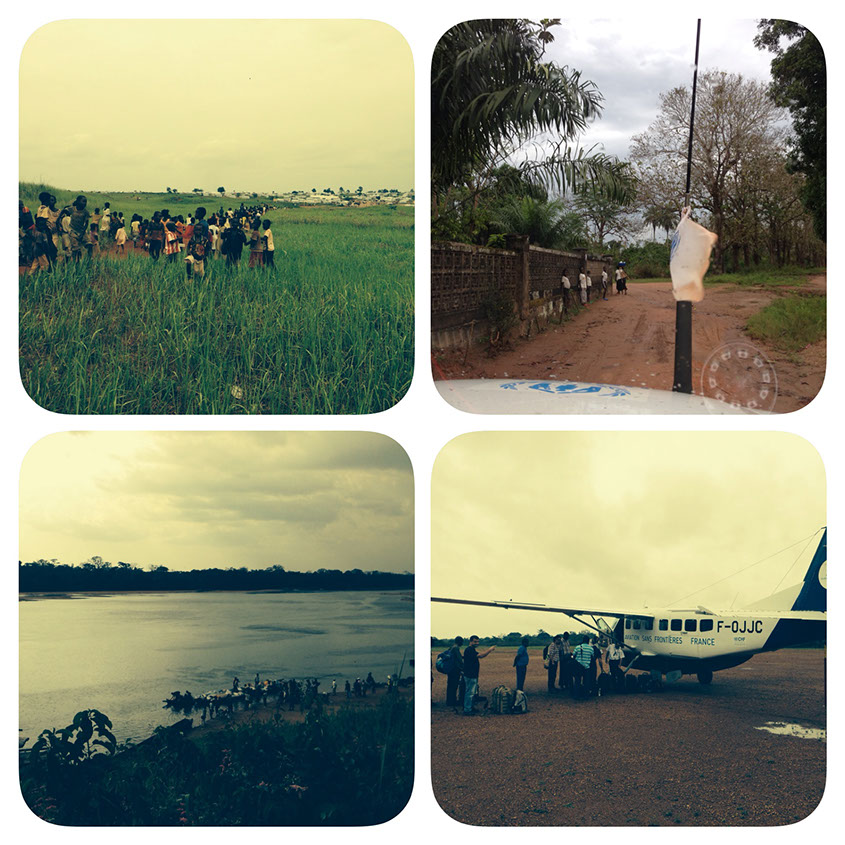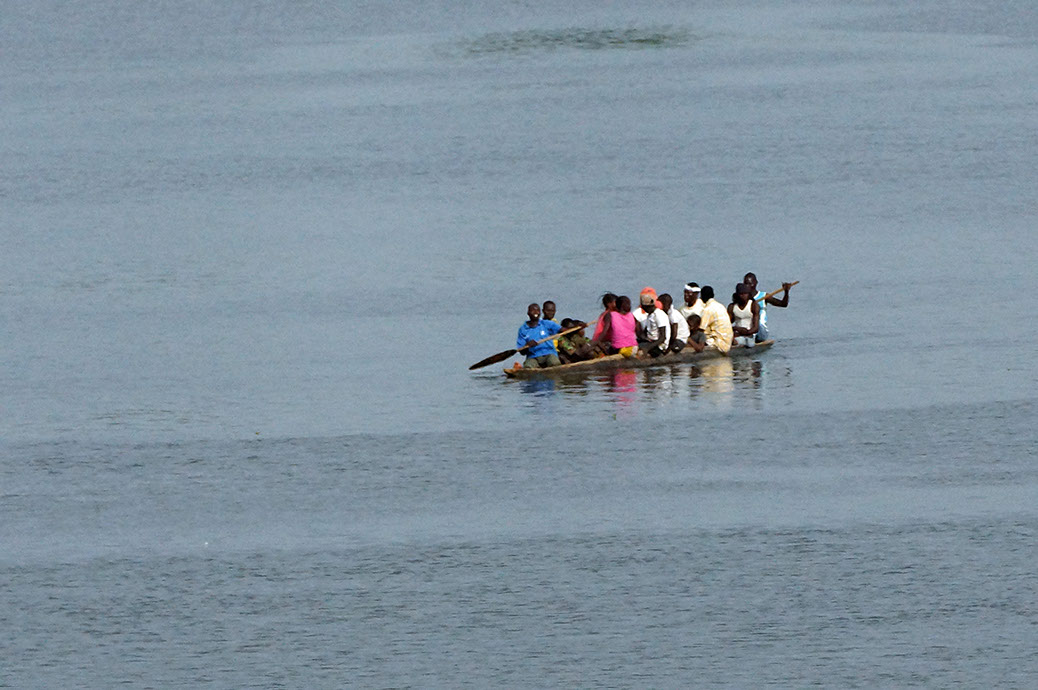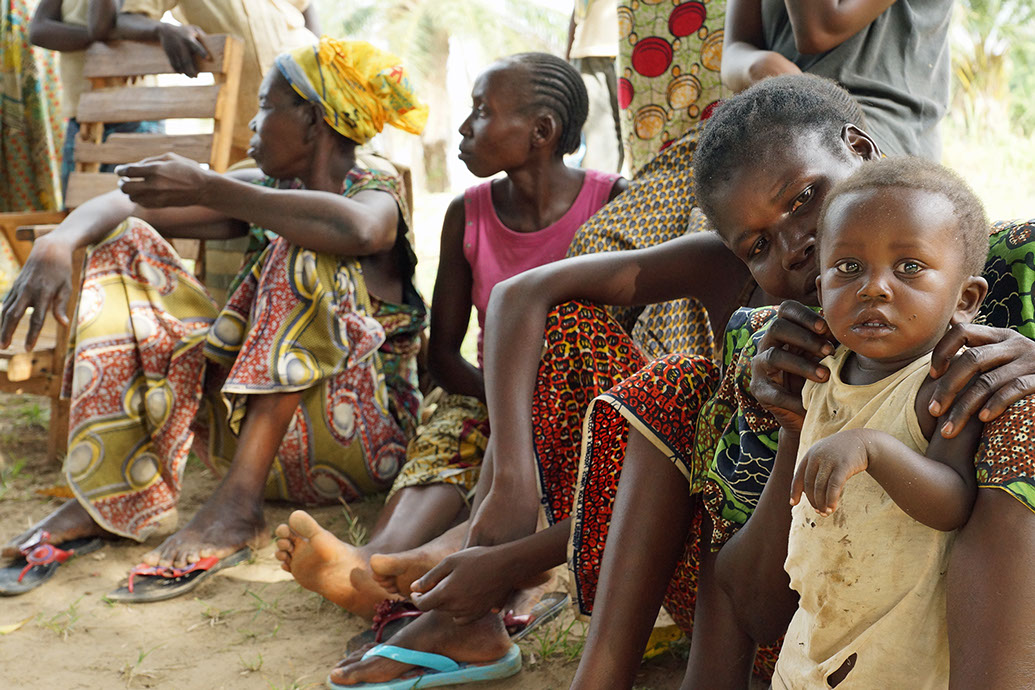The war across the river
FOR TENS OF THOUSANDS OF PEOPLE LOOKING TO ESCAPE THE VICIOUS WAR IN CENTRAL AFRICAN REPUBLIC, CROSSING THE OUBANGI HAS BECOME THE DIFFERENCE BETWEEN LIFE AND DEATH.
The war
The river
No ordinary life
Waiting for God
BETWEEN LIFE & DEATH
THE PIROGUE
The river
The spectacular Oubangi River stretches for thousands of kilometres as the central dividing line between the DRC and CAR. Today, in the midst of the carnage in the CAR, this expanse of fresh water is the difference between life and death for tens of thousands of civilians, just caught in the middle of a vicious conflict.
Between life & death
he Oubangi River carries an open secret. For 1,400km it winds around dense forests and rolling hills, dividing the Central African Republic from the Democratic Republic of Congo.
For the 60,000 refugees who have fled CAR for DRC over the past year, this 300m stretch of water – a mere 10 minute journey by boat – can mean the difference between life and death.
When the violence in Bangui peaked in December and January, ordinary civilians found themselves caught between anti-Balaka militia and Séléka fighters, and the conflict spilled onto the river banks.
"In December, we had up to 1,800 coming across the river every day,"says Zephirin Bangala, head of DRC National Commission of Refugees, a government body in the town of Zongo, across the river from Bangui.
The numbers have since reduced, but there remains a steady stream of refugees, around 30 to 40 every day, he estimates, who continue to cross quietly into DRC in the early morning or late afternoon. It is their best chance of crossing without being noticed, he says.
They try to slip under the long shadows of fishermen busy casting their nets. Officials say many of the men try their best to emulate the fishermen: Carrying few belongings, boarding the boats bare chested, carrying and fiddling with fishing nets, while women behave as traders - until they reach freedom on the other side.
Lampaert Emmanuel, a medical coordinator with Medecins Sans Frontieres (MSF), says the profile of those crossing the river keeps shifting. At one stage, it was mainly urban dwellers, but as Bangui emptied out and some semblance of a security apparatus returned to the capital city, those from rural areas that had been left to the mercy of the militiamen began to make the journey across.
And yet, from the Congolese side of the river, it is not immediately obvious that Bangui or indeed the rest of the country is in the midst of a killing frenzy. Bangui is among the smaller capitals on the continent, known affectionately as La Coquette, or the little pretty one. To the outside world, it is barely a town, but to residents, it is their city. Likewise, the fever gripping this city, sitting on the water’s edge, is not evident to the naked eye.
t
OUBANGI RIVER, DEMOCRATIC REPUBLIC OF CONGO
The Oubangi River operates as the central dividing line between the DRC from CAR and the Republic of Congo

It's hard to believe that beneath these trees, horrific violence has impacted hundreds of thousands of people

Bangui isn't buried beneath plumes of smoke, gunshots don’t echo through the air and screams for help do not reverberate across the water. The calm currents and lush coastal vegetation seem to belie the death and destruction unfolding on its riverbanks. In fact, on the Congolese side of the river, it is virtually business as usual. Fishermen fling their nets and await a catch. Women and children wash pots, their clothes and themselves at the water’s edge. The long, narrow pirogues, as the boats are known in his part of the world, ferry merchants and goods from one side to the other.
Even at night, when Zongo descends into darkness, with only a handful of generators keeping pockets of homes and a restaurant in the light, Bangui appears deceptively normal, calm even. Across the river, streetlights flicker through the shrubs and the trees, homes and buildings proudly perched on the city’s hills seem functional.
But the lack of a spectacle, the absence of any visible signs of conflict, only heightens the sense of fear that has permeated riverside communities. The stories of brutality the refugees bring with them seeps into the psyches of people on both sides. Roger Kotongo, a pharmacist at the only hospital in Zongo, says that the coup brought with it a startling brutality. Zongo was inundated with patients carrying gunshot and stab wounds from across the river.
“Politicians are manipulating the situation in Bangui,” Kotongo says. The numbers have since reduced, but Zongo is struggling. On one hand you have refugees, carrying with them broken dreams and fresh trauma, while on the other hand, you have locals struggling with the rising cost of living as supplies from Bangui dries up. “With the situation in Bangui as they are, things are not working here,” Kotongo says.
Zongo, after all, is a conglomeration of dusty streets, abandoned buildings and splendid greenery. The town, with its reported population of 30,000 people as part of a larger district of 88,000 people, remains in the development doldrums. The town even uses CAR currency because of its dependence on its neighbour for supplies. Like so many parts of DRC, there is limited electricity and running water. Here, the deputy mayor conducts interviews in an office without electricity.
“Politicians are manipulating
the situation in Bangui.”
- ROGER KOTONGO
Across the river in Bangui, there is very little activity on the banks of the Oubangi; it is as if an entire city has been emptied

The pirogue
Another refugee, 26-year-old Hissen Moussa says that getting to the river is often the most difficult part of the journey, with some taxi drivers collaborating with the anti-Balaka militia. "They take you and drop you off with the anti-Balaka," he explains.
Local officials confirm that when the violence was at its height, and no one was allowed to cross, those attempting to flee across the river on pirogues had to take cover by lying flat on the boats, as militiamen fired at them from the water’s edge.
Crossing the river might be easier now, but the natural border only represents the next stage of the struggle for those fleeing their country.
For 29-year-old Natali Tepasho, Zongo would be her third hiding place. "My two children were with my mother, and now I have no idea where any of them are," she says. Another woman, almost nine months pregnant, explains that she doesn’t like the idea that her child will be born across the border, but she has no choice.
Living in Bangui has become too dangerous and now she must hope to receive adequate healthcare in the Mole camp. Officials say the crisis has taken its toll on CAR’s healthcare facilities and few feel safe in the country’s hospitals or clinics. But while gunshots and machete attacks have been the cause of thousands of deaths, MSF says the disruption and displacement caused by the conflict have made malaria and malnutrition among the biggest killers in the CAR.
The journey across the Oubangi, it turns out, is but a brief respite in a story fraught with betrayal, murder and anxiety.
t the Ambassade landing spot, one of five mini ports where traders and refugees disembark, a pirogue drifts gently to the water’s edge. The 15 refugees crammed on board are greeted by two police officers, one of whom carries a semi-automatic weapon.
"Refugee?" they are asked.
One young man, wearing a white vest and bandana, holds a machete. Others have come with little more than the clothes on their back.
Twenty-year-old Roberto Bagiu says he had been hiding with hundreds of others in the St Paul Church on the other side. The church, which is described by scores as their only reprieve as militia burnt homes and destroyed livelihoods across the city, is really just a small, even lonely structure, facing the river. For the people here, the building might as well have been a cantonment for the protection it has provided. But supplies in this church were running out, and Bagiu said he had to take his chances and come across the river. His girlfriend stayed behind.
Another man, 57-year-old Gilbert Palecusu, says he left the city because the fighters were knocking on doors, forcing their way into properties and killing indiscriminately. The presence of French and African forces, he insists, does little to diminish the terror that descends on the city after dark.
a
OUBANGI RIVER, DEMOCRATIC REPUBLIC OF CONGO
The distance between Bangui and Zongo is hardly a 10 minute ride on a pirogue

The violence has disrupted trade, activities between Zongo and Bangui, creating new economic strife

The ferocity of the sporadic attacks has left riverside communities damaged

Those who survive the violence engulfing their country and make it to DRC are faced with a new set of challenges in the form of rampant corruption, disorder and little economic opportunity. Those working in administrative, education or in technology back in Bangui find the irony of their displacement almost too heavy to bear.
On one side, a city with amenities is burning up. On the other side, a town offering a semblance of security and a journey back in time.
And yet, one aid worker explained that refugees were often asked by police officers to pay an “entrance fee”, but no refugee or official would confirm that bribery was taking place at the landing sites. The head of the national refugee commission in Zongo also denied the charge and said his officers were doing their best to exhibit sensitivity towards the new arrivals.
“We are a hospitable people. And they are our neighbours,” Zephirin Bangala, who heads the National Commission of Refugees in Zongo, said. “Most of the people here have family, relatives, friends living in Bangui.”
“We are a hospitable people.
And they are our neighbours.”
- ZEPHIRIN BANGALA (HEAD OF THE DRC NATIONAL REFUGEE COMMISSION)
RETURN TO TOP...
...OR CONTINUE TO NEXT CHAPTER











